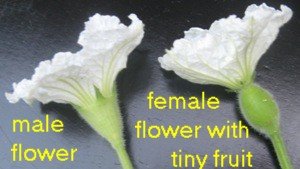





Bottle, kettle, apple, swan; the descriptive names of hardshell gourds tell you this is a fun crop. And, unlike colorful thin shelled gourds which brighten fall displays and soon wither away, hardshell gourds will dry to a permanent and very craftable wooden form. I'd like to give you the basics on growing the best hardshell gourds for crafting fun.
Hardshell gourds (Lagenaria siceraria) are bred to grow a thick rind which will dry to a woody shell over several months of curing. Most readers have seen simple birdhouses made from gourds, but there are seemingly endless ways to decorate, carve, paint, or burn gourds. But first you have to buy the gourds-- or grow them!
Gourd vines need ample room in a sunny garden. Seed companies tell you that the vine can grow to fifteen feet long; what they forget to say is that the vine will branch. By August, you'll have vines trying to grow fifteen feet in all directions. Plan accordingly (or hope that your neighbor is as tolerant as mine.) The heaviest, biggest gourds will have to grow along the ground. Small to medium size gourds will readily climb a trellis.
Now beef up the soil where your gourds will be planted. Gourds love a rich, organic soil. Rodale's All-New Encyclopedia of Organic Gardening says that each gourd plant should be treated to a hearty scoop of composted manure. I'd venture to say that you most likely cannot give a gourd vine too much in the way of finished or even half-finished compost. I've grown a successful crop of bushel gourds right on the top of the previous fall's big leaf based compost pile.
You'll grow gourd vines from seed each spring; rarely would you ever find starter plants sold for these. Most big seed catalogs sell a gourd mix, which may include hardshell gourds. Then again, it may not; read the descriptions carefully or call and ask. Some catalogs sell named varieties of gourd seed. Can you take seeds from a purchased gourd? Yes, you can; they'll probably sprout just fine. But be aware that the resulting gourds may not be exactly like the parent fruit. This link to Dave's Garden PlantScout will show you a long list of named varieties of gourds and vendors who sell the seeds. Descriptives like "cannonball", "bottle" and "apple" sometimes give you a good idea of the shape and size of the mature fruit. There are some real whoppers to be had ("Bushel 120 + lbs") and a few little cuties ("Tiny Bottle.")
Gourds need a long warm summer to develop mature fruit. If you have any doubt whether your summer is long and warm enough, start gourd seeds inside several weeks before last spring frost, the same as you would tomatos. Gourd seeds, and gourd seedlings, are big so give them a roomy pot, at least a four incher, not those little six-packs that you've reused for flowers. Stick four seeds down in the soil and put the pot in a warm spot like your kitchen counter or on top of the refrigerator. Fleshy oval seed leaves will soon appear, signaling you to move that pot to a brightly lit indoor location. Gentle starter fertilizer is helpful. Keep only one or two of the best looking babies per pot and snip off the runts. When you move those babies outside, handle the roots gently and try not to break up the root ball while planting. If your summer IS long and warm, plant gourd seeds outside when the soil is warm, as you do for gourd's cousins like cucumbers or squash. Each well prepped planting hole will support two or three growing vines. Starting with five seeds per hole allows you to choose the best two; after a few weeks of growth, eliminate the pipsqueaks.

Gourds are pretty carefree but they do fall victim to some of the same annoying pests that plague cucumbers, squash and pumpkins. Checking frequently for problems helps you keep them under control. I find that squash bugs love gourds even more than squash. Watch for dark brown adults on the stems, young white or gray bugs underneath the leaves, and clusters of tiny gold eggs. Cucumber beetles love Lagenaria's white, night blooming flowers and can often be handpicked in the morning from inside the blossoms.
By late summer you should find some full size fruits hanging from rangy gourd vines. If all goes as planned you'll have at least two or three full sized gourds per plant. (Remember to check to other half of the vine that's grown into the neighbor's yard.) That's about as much as can be expected. Remove any small fruits that develop in late summer. They won't mature fully and will probably rot. Leave the vines and mature gourds in the garden until the first frost.
Now follow the tags below to read other Dave's Garden articles about the curing and crafting your crop of great gourds.(Subscribers may enjoy growing hints, discussions, and fabulous gourd pictures by participating in the Gourd Forum Community within Dave's Garden.)
~~~~~~~~~~~~o~~~~~~~~~~~~~~~~
Pictures taken by and property of the author.
(Editor's Note: This article was originally published on October 23, 2009. Your comments are welcome, but please be aware that authors of previously published articles may not be able to promptly respond to new questions or comments.)
Copyright © www.100flowers.win Botanic Garden All Rights Reserved